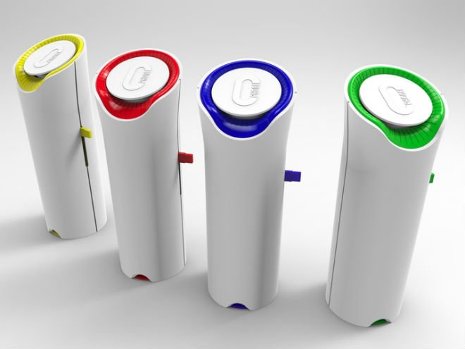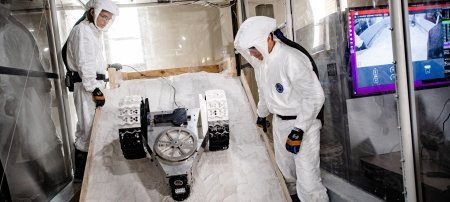Scents that are Sent: oPhone Delivers Aromas

Say you forgot about Valentine’s Day, and it’s too late to send that certain someone some roses. Someday, you’ll at least be able to send their scent.
A Paris laboratory under the direction of David Edwards, Michigan Technological University alumnus, has created the oPhone, which will allow odors—oNotes—to be sent, via Bluetooth and smartphone attachments, to oPhones across the state, country or ocean, where the recipient can enjoy American Beauties or any other variety of rose.
It can be sent via email, tweet, or text.
Edwards says the idea started with student designers in his class at Harvard, where he is a professor.
“We invite young students to bring their design dreams,” he says. “We have a different theme each year, and that year it was virtual worlds.”
The all-female team came up with virtual aromas, and he brought two of the students to Paris to work on the project. Normally, he says, there’s a clear end in sight, but with their project no one had a clue who was going to pay for the research or if there was even a market.
With the early major buzz produced—Wired Magazine, National Public Radio, and the British press—Edwards is sure the market will come.
So, how does the scent technology work?
“We create unique aromatic profiles,” says Blake Armstrong, director of business communications at Vapor Communications, an organization operating out of Le Laboratorie (Le Lab) in Paris. “We put that into the oChip that faithfully renders that smell.”
Edwards said that the initial four chips that will come with the first oPhones can be combined into thousands different odors—produced for 20 to 30 seconds—creating what he calls “an evolution of odor.”
The secret is in accurate scent reproduction, locked in those chips plugged into the devices. Odors are first captured in wax after they are perfected using “The Nose”-- an aroma expert at Le Lab, Marlène Staiger -- who deconstructs the scents.
For example, with coffee, “the most universally recognized aroma,” she replaces words like “citrus” or “berry” with actual scents that will be created by ordering molecules and combining them in different percentages.
In fact, Le Lab is working with Café Coutume, the premier coffee shop in Paris, housing baristas in their building and using oPhones to create full sensory experiences.
“Imagine you are online and want to know what a particular brand of coffee would smell like,” Edwards says. “Or, you are in an actual long line waiting to order. You just tap on the oNote and get the experience.”
The result for Coutume, and all oPhone recipients, is a pure cloud of scent close to the device. Perhaps six inches in diameter, it is released and then disappears, retaining its personal and subtle aura.
And there other sectors that could benefit, Edwards says.
“Fragrance houses, of course, culinary, travel, but also healthcare.”
He cites an example at an exhibition last fall in London when someone with brain damage came forward. He had lost memory, and with it his sense of taste and smell. The oPhone can help bring that memory back, Edwards says.
“We think there could be help for Alzheimer’s patients, related to the decline and loss of memory and olfactory sensation,” he says.
He’s come a long way from a wayward student who nearly joined the Air Force as an undergraduate at Michigan Tech.
“Anton Pintar [professor emeritus] was my greatest mentor,” Edwards says. “I was an unmotivated student until I took an applied math class with him, and he helped me get into grad school.”
“I’m definitely applying all that math now!”
Improvements are already planned for an end-of-year Beta release of the scent-transmitting phone to a limited audience. They’ll be seeking feedback before a broader release in 2015. The oPhone will eventually be smaller, “more intimate,” according to Armstrong.
Form and function are both important to the oPhone, Armstrong says. And there’s something more.
“At the end or the day, it helps open up your life to share,” Armstrong says. “You can share your world and how you experience it with someone special.”
Michigan Technological University is an R1 public research university founded in 1885 in Houghton, and is home to nearly 7,500 students from more than 60 countries around the world. Consistently ranked among the best universities in the country for return on investment, Michigan's flagship technological university offers more than 185 undergraduate and graduate degree programs in science and technology, engineering, computing, forestry, business, health professions, humanities, mathematics, social sciences, and the arts. The rural campus is situated just miles from Lake Superior in Michigan's Upper Peninsula, offering year-round opportunities for outdoor adventure.




Comments